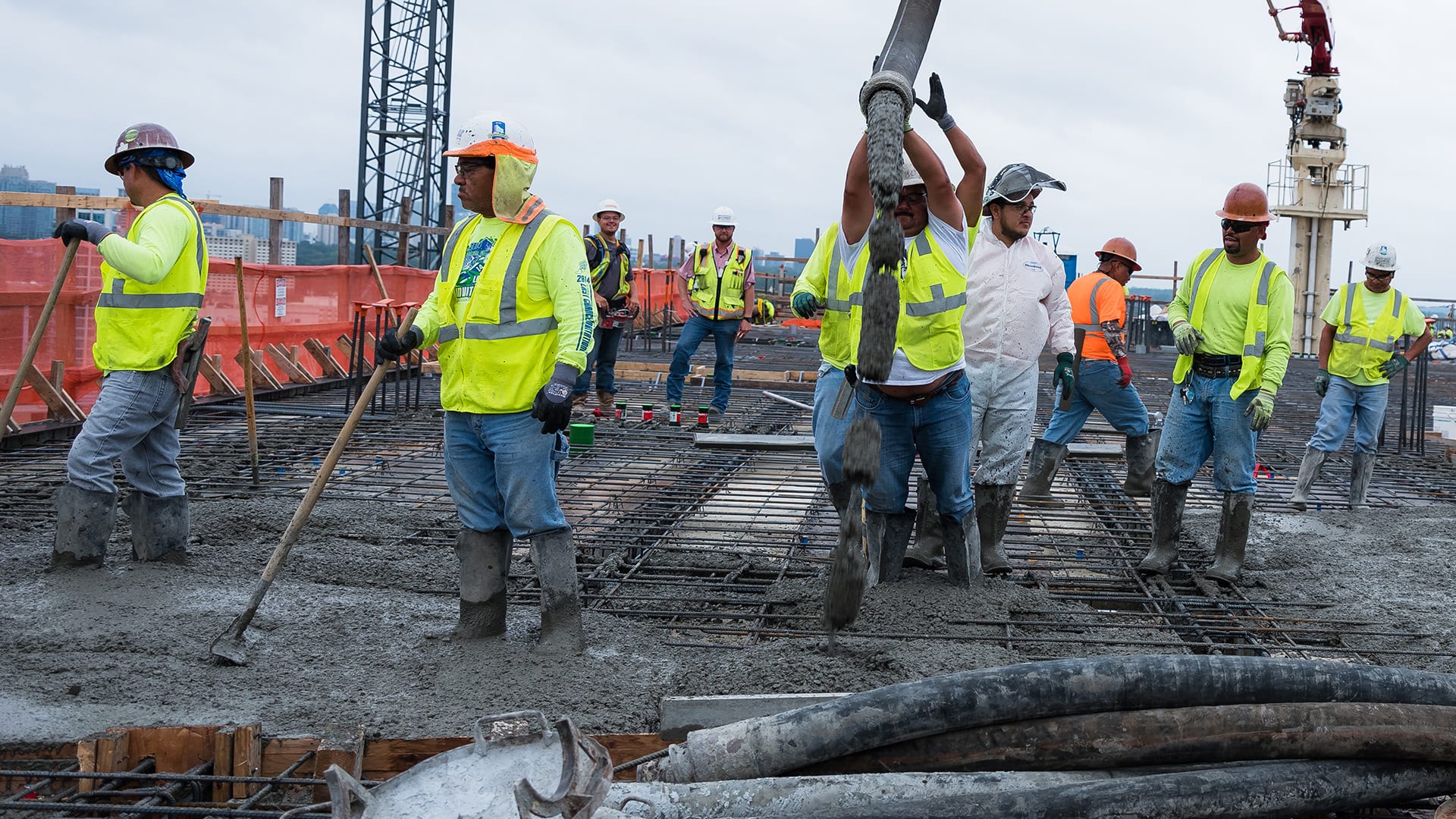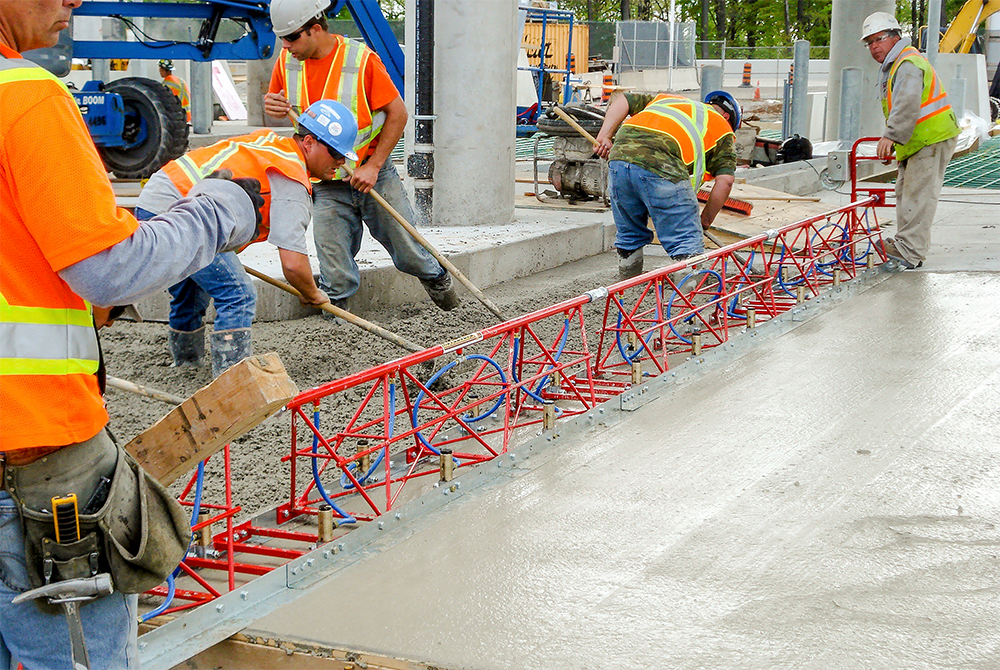Avoid These Mistakes When Hiring West Coast GE Concrete contractors for Your Next Job
Avoid These Mistakes When Hiring West Coast GE Concrete contractors for Your Next Job
Blog Article
The Vital Duty of Concrete Foundation in Structural Honesty and Long Life
When it involves developing a residential property, the foundation is a lot more essential than you may think. Concrete structures supply unmatched strength and resilience, ensuring your structure can withstand various environmental difficulties. Without a strong base, you take the chance of potential problems like shifting or splitting, which can compromise security and worth. Recognizing the subtleties of concrete foundations can be the secret to preserving your financial investment for years ahead. So, what should you consider next?
Comprehending the Relevance of Concrete Foundations
Concrete structures are crucial to the overall stability of any kind of structure, as they supply the important assistance required to stand up to different lots and ecological conditions. When you consider constructing a home or an industrial space, the foundation is the first point you must think about. It acts as an obstacle against dampness, securing your residential or commercial property from water damages. A well-placed concrete structure likewise avoids settling and changing, which can result in cracks in wall surfaces and floors. You'll intend to guarantee that the structure is appropriately designed and reinforced, as this affects the long life of your building. Additionally, a strong structure can improve power effectiveness by decreasing air leaks. Bear in mind, overlooking the value of a concrete structure can lead to pricey repairs down the line. Spending in a high quality foundation upfront is important for the integrity and sturdiness of your structure.
Benefits of Concrete Foundations for Architectural Stability
While several aspects add to a structure's structural integrity, concrete structures provide unequaled resilience and stamina. You'll appreciate that concrete can stand up to severe weather condition problems, withstanding both dampness and temperature fluctuations. This resilience indicates your framework is much less most likely to experience cracking or shifting gradually, which can jeopardize its safety.Additionally, concrete's fundamental weight offers a solid base, stopping activity throughout all-natural events like earthquakes or floodings. When you choose a concrete structure, you're likewise choosing for low maintenance; unlike timber, it will not rot or draw in bugs, saving you money and time in repairs.Moreover, concrete's fire resistance provides included safety, guaranteeing your structure can sustain heats without significant damages. In general, purchasing a concrete foundation suggests you're prioritizing the long-lasting security and stability of your structure, making it a sensible option for any type of building and construction project.
Usual Types of Concrete Foundations
When it concerns constructing structures, recognizing the usual types of concrete structures can help you make educated options for your task. One of the most common types consist of slab-on-grade, crawl room, and complete basement foundations.A slab-on-grade structure is an easy, cost-effective alternative, where a thick concrete piece is poured directly on the ground. This kind works well in warm climates, as it lessens warm loss.Crawl room foundations boost the home somewhat above ground, enabling ventilation and accessibility to pipes and electrical systems. This design can assist protect against moisture issues.Full cellar structures offer added living or storage room while supplying excellent architectural assistance. They need more excavation and are normally made use of in cooler environments to stop frost heave.
Factors to Think About When Designing a Concrete Structure

Ideal Practices for Setting Up Concrete Foundations
When you're mounting a concrete structure, correct site preparation is necessary to assure security (West Coast General Engineering concrete foundation). You'll also need to recognize support methods to enhance strength and toughness. Finally, do not neglect the curing procedure, as it plays an essential role in achieving a strong structure
Website Preparation Value
Although it might seem uncomplicated, correct website prep work is essential for ensuring a solid and resilient concrete structure. Start by removing the location of any particles, greenery, or natural product that might endanger the foundation's integrity. Next off, examine the soil kind and compaction; you might require to excavate or include materials to develop a stable base. Level the ground to assure even weight circulation and stay clear of resolving concerns in the future. Mounting appropriate water drainage systems is also necessary to stop water accumulation, which can deteriorate the foundation over time. Mark out the structure's dimensions precisely to direct the pouring procedure. By following these actions, you'll establish the phase for an effective concrete structure that stands the test of time.
Reinforcement Strategies Described
When the website is effectively prepared, the following action in ensuring a strong concrete foundation involves carrying out reliable support methods. You must begin by making use of steel rebar, which provides tensile stamina and assists avoid cracking. Lay the rebar in a grid pattern, making sure it's elevated utilizing spacers to keep appropriate protection. Furthermore, think about making use of cord mesh for added support, especially in locations based on heavy loads. Do not forget to connect the rebar crossways securely with cord. For larger structures, fiber reinforcement can improve resilience, lowering the threat of contraction cracks. Always adhere to local building regulations and standards to make certain compliance. By using these reinforcement methods, you'll considerably enhance your foundation's toughness and longevity, laying a solid foundation for your framework.
Curing Process Fundamentals
To assure your concrete foundation treatments properly, it's vital to keep sufficient moisture and temperature level conditions quickly after putting. Beginning by covering the surface with a wet burlap or plastic sheeting to keep wetness. This maintains the concrete hydrated, protecting against splits and making sure toughness. You must additionally keep track of the temperature; optimal treating problems are in between 50 ° F and 90 ° F. If it's also warm, haze the surface routinely to avoid fast evaporation. For chilly weather, take into consideration making use of protecting coverings to preserve warmth. Aim for a curing duration of at the very least seven days, as this is vital for optimum stamina growth. By complying with these best practices, you'll boost your foundation's resilience and longevity, guaranteeing structural integrity for several years to find.
Upkeep of Concrete Structures for Longevity
To keep your concrete structure strong and long lasting, routine evaluations are necessary. You should also guarantee reliable drainage options remain in area to avoid water damage. If you find any type of splits, addressing them promptly will save you from bigger troubles down the line.

Regular Examinations and Assessments
While normal inspections and assessments could look like a chore, they're necessary for preserving the honesty of your concrete structure. By consistently checking for fractures, changes, or indicators of wear, you can catch possible problems before they intensify into costly repair services. Seek any kind of water pooling around the structure or unusual settling, as these can signal underlying problems. It's also important to keep an eye on any type of adjustments in your home's structure, like doors that stick or windows that do not open efficiently. Keeping a document of your examinations aids track modifications over time, permitting proactive upkeep. Eventually, these assessments ensure your foundation stays steady, supporting the durability and safety of your entire structure. Do not neglect this important aspect of homeownership!
Efficient Water Drainage Solutions
Normal examinations can expose concerns like water drainage troubles that may endanger your concrete foundation's security. To stop water buildup, ensure your rain gutters and downspouts straight water far from the structure. Installing French drains pipes can properly redirect surface area and groundwater, lowering stress on your foundation wall surfaces. In addition, grading the soil around your home assists ensure that water moves away, instead than merging near your foundation.Consider making use of sump pumps in locations prone to flooding, as they actively remove excess water. Consistently check for clogs in drain systems and clear them promptly. You'll protect your foundation's integrity and durability by taking these positive actions. Bear in mind, efficient drain options are necessary for keeping a solid, long lasting concrete structure.
Motivate Fracture Repair Works
When you observe fractures in your concrete foundation, resolving them immediately is necessary for preserving its longevity. Little cracks can swiftly develop into bigger issues, endangering the structural honesty of your home. Consistently check your foundation for indicators of damage, such as straight or upright fractures. If you identify any type of, do not wait-- fix them instantly. You can use epoxy shots or concrete patching substances, which are effective for sealing cracks. Always comply with the producer's instructions and consider getting in touch with an expert West Coast General Engineering industrial concrete Rancho Cucamonga for considerable damages. Keep in mind, timely fixings not only boost your structure's durability yet likewise conserve you money in the long run by preventing extra extensive repair work down the line. Keep aggressive, and your foundation will stay strong and safe and secure.
Addressing Common Problems With Concrete Structures
Concrete structures can deal with different concerns with time, making it crucial to identify and resolve them without delay. Among one of the most common issues is cracking, which can take place because of temperature fluctuations or settling dirt. If you notice splits, it's crucial to examine their dimension and deepness; small fractures can usually be secured, while bigger ones may need expert evaluation.Water breach is another major issue. Excess wetness can bring about mold growth and architectural damage. Warranty proper drain around your structure to mitigate this risk. Furthermore, seek signs of shifting or bowing walls, as this can indicate underlying problems with your foundation's stability.Regular inspections are fundamental to catch these problems early. If you identify any kind of worrying indicators, do not wait to consult a foundation expert. By staying aggressive, you can preserve the honesty and durability of your concrete structure, guaranteeing your home remains safe and safe.
Frequently Asked Inquiries
How Does Dirt Kind Influence Concrete Structure Efficiency?
Soil kind considerably influences concrete foundation efficiency. If you've got expansive clay, for circumstances, it can trigger moving and cracking. Sandy soil might lead to clearing up. Comprehending your soil helps guarantee a secure structure.
Can Concrete Foundations Be Fixed if Damaged?
Yes, you can repair broken concrete foundations. Depending upon the degree of the damage, techniques like epoxy injection or piece jacking can bring back stability. It's ideal to seek advice from an expert for efficient solutions.
What Is the Typical Life-span of a Concrete Foundation?
A concrete structure typically lasts 30 to 100 years, depending on elements like soil problems, environment, and upkeep. You'll wish to keep an eye on it to ensure it stays in great shape throughout its lifespan.
Exist Option Materials to Concrete for Foundations?
Yes, there are choices to concrete for structures, like steel, hardwood, or perhaps recycled materials. Each option has unique advantages and drawbacks, so you should consider your task's specific demands when selecting the ideal product.
Exactly How Does Environment Impact Concrete Structure Resilience?
Climate substantially influences concrete foundation longevity (WCGE commercial concrete). Severe temperature levels, moisture, and freeze-thaw cycles can deteriorate the material, leading to splits and structural issues. You should take into consideration local environment conditions when preparing your structure to ensure long-term efficiency
Report this page